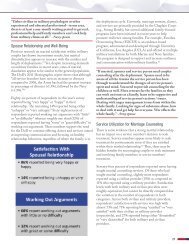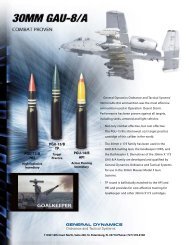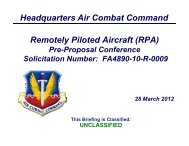F-35 Joint Strike Fighter (JSF) - WordPress.com
F-35 Joint Strike Fighter (JSF) - WordPress.com
F-35 Joint Strike Fighter (JSF) - WordPress.com
Create successful ePaper yourself
Turn your PDF publications into a flip-book with our unique Google optimized e-Paper software.
DOD PROGRAMS<br />
to outperform other fielded systems. To be effective, it<br />
must trigger on smaller leak rates, down to 2 gpm versus<br />
the 6 gpm typical of other aircraft designs, without causing<br />
excessive false alarms.<br />
--<br />
The program is currently working to identify a low leak<br />
rate technical solution. The Program Office will consider<br />
operational feasibility and effectiveness of the design,<br />
along with cost, to decide if PAO shutoff valves will be<br />
reinstated as part of the production aircraft configuration.<br />
• Another test in this series, LF-19D-16, identified the<br />
vulnerability associated with fuel fires from fueldraulic system<br />
leaks. The fueldraulic system is a fuel-based hydraulic system<br />
used to control the engine exhaust nozzle. It introduces a<br />
significant amount of fuel plumbing to the aft end of the<br />
engine and, consequently, an increased potential for fire.<br />
--<br />
This test confirmed the increase in vulnerability. The<br />
original aircraft design included flow fuses, also known<br />
as excess flow check valves, to cutoff fuel flow when a<br />
leak is sensed due to downstream fuel line damage or<br />
failure. As a result of the weight-reduction initiative,<br />
the JESB directed removal of fueldraulic fuses from<br />
the production design in 2008 to provide weight saving<br />
of 9 pounds. Fuses, however, were still part of the<br />
non‐weight‐optimized F-<strong>35</strong>A test article used in this test.<br />
--<br />
While a ballistic test with fragment threats demonstrated<br />
that the fueldraulic system poses a fire-related<br />
vulnerability to the F-<strong>35</strong>, the leak rates generating the fire<br />
were insufficient to trigger the fuses. Since the fuses did<br />
not shut off the flow, the result was a sustained fuel‐based<br />
fire.<br />
--<br />
The Program Office is accepting the increased<br />
vulnerability associated with the fueldraulic system and is<br />
currently not considering reinstating the fueldraulic fuses<br />
in the production aircraft configuration.<br />
• A Computation of Vulnerable Area Tool analysis shows that<br />
the removal of the PAO coolant and fueldraulic systems<br />
results in a 25 percent increase in aircraft vulnerability.<br />
Ballistic Analysis<br />
• The program used a <strong>com</strong>putational analysis, supported by<br />
single fragment test data, to evaluate the vulnerabilities of the<br />
F-<strong>35</strong> to multiple missile warhead fragment hits for several<br />
encounter geometries.<br />
--<br />
Multiple missile warhead fragment hits are more<br />
<strong>com</strong>bat‐representative and will result in <strong>com</strong>bined damage<br />
effects that need to be assessed. For example, aircraft<br />
may not be lost due to a fuel leak from a single missile<br />
fragment impact, but <strong>com</strong>bined leakage from multiple<br />
impacts could prevent the aircraft from returning to base.<br />
--<br />
There are potentially other such <strong>com</strong>bined effects that<br />
are not known or expected and that, due to the analysis<br />
limitations, cannot be identified. These limitations will<br />
introduce a level of uncertainty in the F-<strong>35</strong> vulnerability<br />
assessment.<br />
• The program used the results of the <strong>com</strong>pleted tests to assess<br />
the effects of ballistic damage on the capability of the aircraft<br />
to maintain controlled flight.<br />
--<br />
These estimates are typically expressed as a function<br />
of time intervals, i.e., 0 minutes (“catastrophic kill”),<br />
30 seconds (“K-kill”), 5 minutes (“A-kill”), 30 minutes<br />
(“B-kill”), etc.; however, the program categorized them in<br />
terms that supported their specification <strong>com</strong>pliance, i.e.,<br />
“Loss of Aircraft” or the ability to “Return to Forward<br />
Line of Troops (FLOT).”<br />
--<br />
These limited categories do not provide detailed insight<br />
into the vulnerability of the aircraft. For example, with<br />
a Return to FLOT criterion of 55 minutes, if the aircraft<br />
could fly for 45 minutes it would still be classified as<br />
a Loss of Aircraft and no understanding is provided<br />
concerning the aircraft’s actual capability to maintain<br />
controlled flight for those 45 minutes. Such an assessment<br />
does not provide insight into the actual operational<br />
survivability of the aircraft because it only focuses on the<br />
ability of the aircraft to fly for 55 minutes even though,<br />
in some instances, the pilot might need much less time to<br />
return to friendly territory.<br />
STOVL Propulsion System Test Series<br />
• The program <strong>com</strong>pleted most of the STOVL propulsion<br />
system test series. The Program Office temporarily suspended<br />
this test series due to budget constraints without notifying<br />
DOT&E. The remaining lift fan-to-clutch drive shaft and lift<br />
fan clutch static and dynamic tests have been postponed until<br />
FY13.<br />
--<br />
The LFT&E STOVL propulsion system tests confirmed<br />
that back-ups to hydraulic systems that configure the<br />
STOVL propulsion system for its various operating modes<br />
worked as intended.<br />
--<br />
The <strong>com</strong>pleted test events targeted the lift fan rotating and<br />
stator <strong>com</strong>ponents while the fan was static. The program<br />
assumed that the lift fan would most likely be hit while in<br />
forward flight and that hits during STOVL flight were less<br />
likely. In most test events, the system was then run up to<br />
simulate a STOVL landing sequence.<br />
--<br />
The results indicated that test damage introduced<br />
no measurable degradation in STOVL propulsion<br />
performance, including cascading damage effects, and<br />
would be undetectable by the system and the pilot.<br />
However, due to concerns for catastrophic lift fan or drive<br />
train damage that would risk loss of the test article for<br />
subsequent tests, this test series did not include dynamic<br />
tests to the inboard portion of the lift fan blade, where the<br />
cross section is smaller and centrifugal forces are higher,<br />
making failure more likely.<br />
--<br />
The engine manufacturer is providing damage tolerance<br />
estimates for these threat-target conditions, which still<br />
need to be evaluated.<br />
40 F-<strong>35</strong> <strong>JSF</strong>






